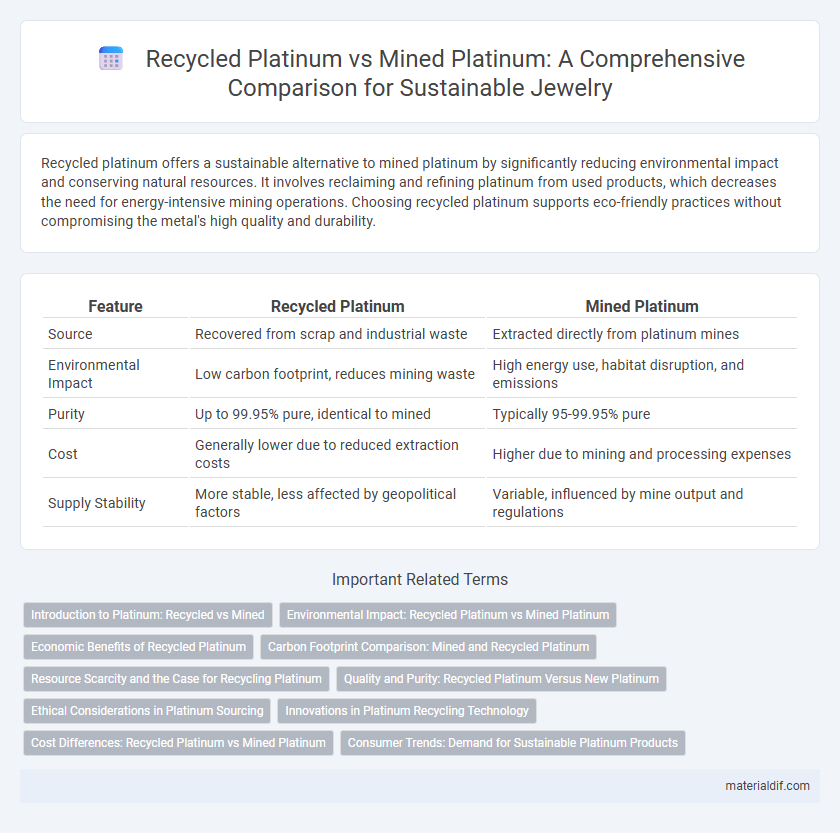Recycled platinum offers a sustainable alternative to mined platinum by significantly reducing environmental impact and conserving natural resources. It involves reclaiming and refining platinum from used products, which decreases the need for energy-intensive mining operations. Choosing recycled platinum supports eco-friendly practices without compromising the metal's high quality and durability.
Table of Comparison
| Feature | Recycled Platinum | Mined Platinum |
|---|---|---|
| Source | Recovered from scrap and industrial waste | Extracted directly from platinum mines |
| Environmental Impact | Low carbon footprint, reduces mining waste | High energy use, habitat disruption, and emissions |
| Purity | Up to 99.95% pure, identical to mined | Typically 95-99.95% pure |
| Cost | Generally lower due to reduced extraction costs | Higher due to mining and processing expenses |
| Supply Stability | More stable, less affected by geopolitical factors | Variable, influenced by mine output and regulations |
Introduction to Platinum: Recycled vs Mined
Platinum, a rare and valuable metal, is sourced through both recycled and mined methods, each impacting environmental and economic factors differently. Recycled platinum is extracted from scrap materials, reducing the need for extensive mining operations and lowering carbon emissions associated with extraction. Mined platinum, sourced primarily from South Africa and Russia, involves energy-intensive processes with greater ecological disruption but remains a critical supply for industrial and jewelry markets.
Environmental Impact: Recycled Platinum vs Mined Platinum
Recycled platinum significantly reduces environmental impact compared to mined platinum by eliminating the need for extensive mining operations that cause habitat destruction, soil erosion, and water pollution. Recycling platinum consumes less energy, lowering carbon emissions and reducing the overall ecological footprint. This sustainable approach preserves natural resources while providing a high-quality source of platinum for industrial and jewelry applications.
Economic Benefits of Recycled Platinum
Recycled platinum offers significant economic benefits by reducing production costs and decreasing reliance on expensive mining operations, which are subject to volatile market prices. Utilizing recycled platinum supports a more sustainable supply chain, lowering expenses related to environmental remediation and regulatory compliance commonly associated with traditional mining. The efficient recovery and reuse of platinum also promote resource conservation, enabling increased profitability through reduced raw material procurement expenses.
Carbon Footprint Comparison: Mined and Recycled Platinum
Recycled platinum has a significantly lower carbon footprint compared to mined platinum, reducing greenhouse gas emissions by up to 70%. The extraction process of mined platinum involves energy-intensive mining operations and ore refining, contributing heavily to environmental degradation and high carbon emissions. Utilizing recycled platinum supports sustainable practices by minimizing energy consumption and lowering the overall carbon footprint within the precious metals industry.
Resource Scarcity and the Case for Recycling Platinum
Recycled platinum significantly reduces the strain on finite natural resources by reusing existing metal, addressing the growing scarcity of mined platinum deposits estimated to last only a few decades at current extraction rates. Mining platinum is energy-intensive and environmentally disruptive, involving habitat destruction and high carbon emissions, whereas recycling platinum requires up to 85% less energy and generates fewer pollutants. The increasing demand for platinum in automotive catalysts and electronics underscores the necessity of recycling to conserve resource availability and promote sustainable production.
Quality and Purity: Recycled Platinum Versus New Platinum
Recycled platinum matches the same high standards of quality and purity as newly mined platinum, often achieving 95-99.9% purity after advanced refining processes. Both recycled and mined platinum undergo rigorous testing to meet industry-grade requirements, ensuring consistent performance for jewelry, electronics, and catalytic converters. The eco-friendly appeal of recycled platinum does not compromise its metallurgical properties, offering a sustainable alternative without sacrificing material excellence.
Ethical Considerations in Platinum Sourcing
Recycled platinum offers a significantly lower environmental impact compared to mined platinum, reducing the need for disruptive mining activities that often involve unethical labor practices and habitat destruction. Ethical sourcing of recycled platinum ensures traceability and minimizes association with conflict minerals or exploitative labor conditions commonly reported in platinum mining regions like South Africa. Prioritizing recycled platinum supports sustainable luxury markets and aligns with increasing consumer demand for responsible metal procurement.
Innovations in Platinum Recycling Technology
Innovations in platinum recycling technology have significantly improved the efficiency and purity of recovering recycled platinum from industrial catalysts and electronic waste. Advanced hydrometallurgical processes and selective leaching techniques enable higher yield and reduced environmental impact compared to traditional mining methods. These cutting-edge technologies support sustainable supply chains by lowering dependency on primary mined platinum and promoting circular economy principles.
Cost Differences: Recycled Platinum vs Mined Platinum
Recycled platinum typically costs 15-30% less than mined platinum due to lower extraction and processing expenses, which reduce energy consumption and environmental impact. The platinum recycling process bypasses costly mining operations, including ore extraction and refining, leading to significant savings passed on to manufacturers and consumers. Price fluctuations in mined platinum are also influenced by geopolitical risks and supply chain complexities, making recycled platinum a more stable and cost-effective alternative.
Consumer Trends: Demand for Sustainable Platinum Products
Consumer demand for sustainable platinum products has surged as environmental awareness intensifies worldwide. Recycled platinum offers a lower carbon footprint and reduces reliance on mining, appealing to eco-conscious buyers in jewelry and automotive industries. Market studies indicate a growing preference for recycled platinum, driving brands to prioritize ethically sourced and sustainable materials.
Recycled Platinum vs Mined Platinum Infographic

 materialdif.com
materialdif.com